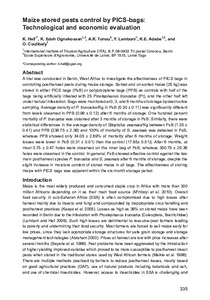| dc.contributor.author | Hell, K. |
| dc.contributor.author | Ognakossan, K. |
| dc.contributor.author | Tonou, A.K. |
| dc.contributor.author | Lamboni, Y. |
| dc.contributor.author | Adabe, K. Edoh |
| dc.contributor.author | Coulibaly, O. |
| dc.date.accessioned | 2019-12-04T11:07:48Z |
| dc.date.available | 2019-12-04T11:07:48Z |
| dc.date.issued | 2012 |
| dc.identifier.citation | Hell, K., Ognakossan, K., Tonou, K.E., Lamboni, Y., Adabe, K.E. & Coulibaly, O. (2012). Maize stored pests control by PICS-bags: technological and economic evaluation. In O. Boukar, O. Coulibaly, C. Fatokun, K. Lopez, M. Tamo, Innovative research along the cowpea value chain: proceedings of the fifth World Cowpea conference on improving livelihoods in the cowpea value chain through advancement in science, held in Saly, Senegal, 27 September-1 October 2010, (p. 334-342), Ibadan: International Institute of Tropical Agriculture. |
| dc.identifier.isbn | 978-978-8444-07-7 |
| dc.identifier.uri | https://hdl.handle.net/20.500.12478/1592 |
| dc.description.abstract | A trial was conducted in Benin, West Africa to investigate the effectiveness of PICS bags in controlling postharvest pests during maize storage. Sorted and un-sorted maize (25 kg) was stored in either PICS bags (PsB) or polypropylene bags (PPB) as controls with half of the bags being artificially infested with 25 Prostephanus truncatus (Pt), and the other half left under natural infestation. Bags were monitored at 0, 3, and 6 months of storage by destructive sampling. Average density of P. truncatus/Kg in PsB (0.30 ± 0.11) was significantly different from levels observed in PPB (0.96 ± 0.12) after 6 months of storage. One hundred percent mortality of P. truncatus was obtained after 3 months of storage in PsB. Similarly, there were statistical differences in the average density of Sitophilus zeamais/Kg between PsB (1.35 ± 0.41) and PPB (238.75 ± 2.38) and 100% of mortality of S. zeamais was detected in PsB, whereas PPB showed only 34.05 ± 2.69% of mortality after 6 months of storage. Weight losses were lower in PsB (0.31 ± 0.01) than the control (17.95± 0.51)). After 6 months, at most 0.75 ± 0.47 holes were observed on the inner bag of PsB, whereas 350.75 ± 25.38 holes were observed in the control. In general, PsB showed effective control against the two main postharvest species P. truncatus and S. zeamais after 6 months of storage, despite the slight increase in moisture content of stored maize in all bags. The effectiveness of storing maize with PICS bags was apparent within the six-month storage period. |
| dc.format.extent | 335-342 |
| dc.language.iso | en |
| dc.publisher | IITA |
| dc.subject | Maize |
| dc.subject | Grain |
| dc.subject | Cost Benefit Analysis |
| dc.subject | New Technology |
| dc.subject | Postharvest Technology |
| dc.subject | Polypropylene Bags |
| dc.subject | Pics Bags |
| dc.subject | Postharvest Pests |
| dc.title | Maize stored pests control by PICS-bags: technological and economic evaluation |
| dc.type | Book Chapter |
| dc.description.version | Peer Review |
| cg.contributor.crp | Policies, Institutions and Markets |
| cg.contributor.affiliation | International Institute of Tropical Agriculture |
| cg.contributor.affiliation | Université de Lomé |
| cg.coverage.region | West Africa |
| cg.coverage.country | Nigeria |
| cg.authorship.types | CGIAR and developing country institute |
| cg.iitasubject | Handling, Transport, Storage And Protection Of Agricultural Products |
| cg.iitasubject | Maize |
| cg.iitasubject | Pests Of Plants |
| cg.iitasubject | Post-Harvesting Technology |
| cg.howpublished | Formally Published |
| cg.publicationplace | Ibadan, Nigeria |
| cg.accessibilitystatus | Limited Access |
| local.dspaceid | 82275 |
| cg.targetaudience | Scientists |

